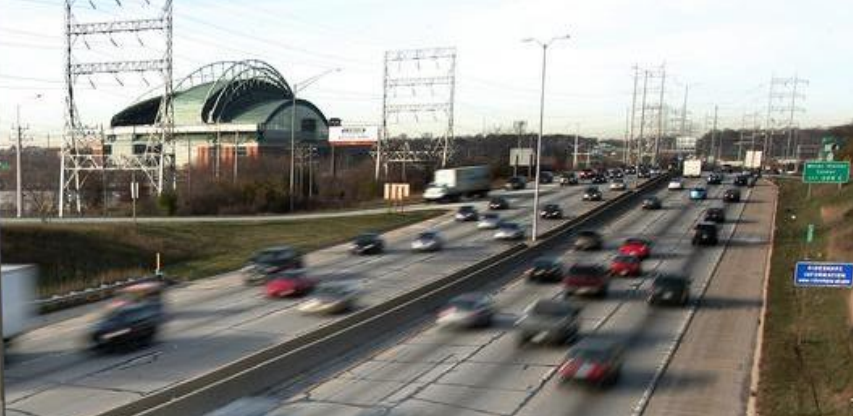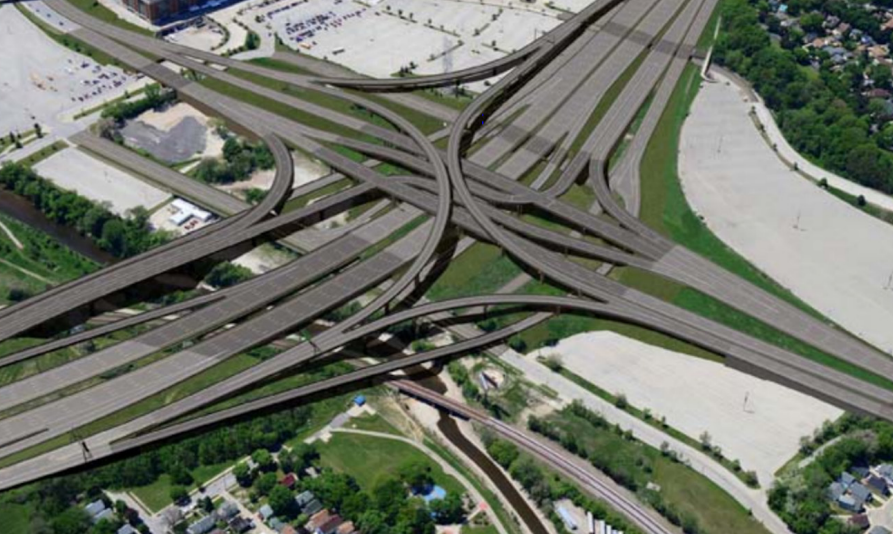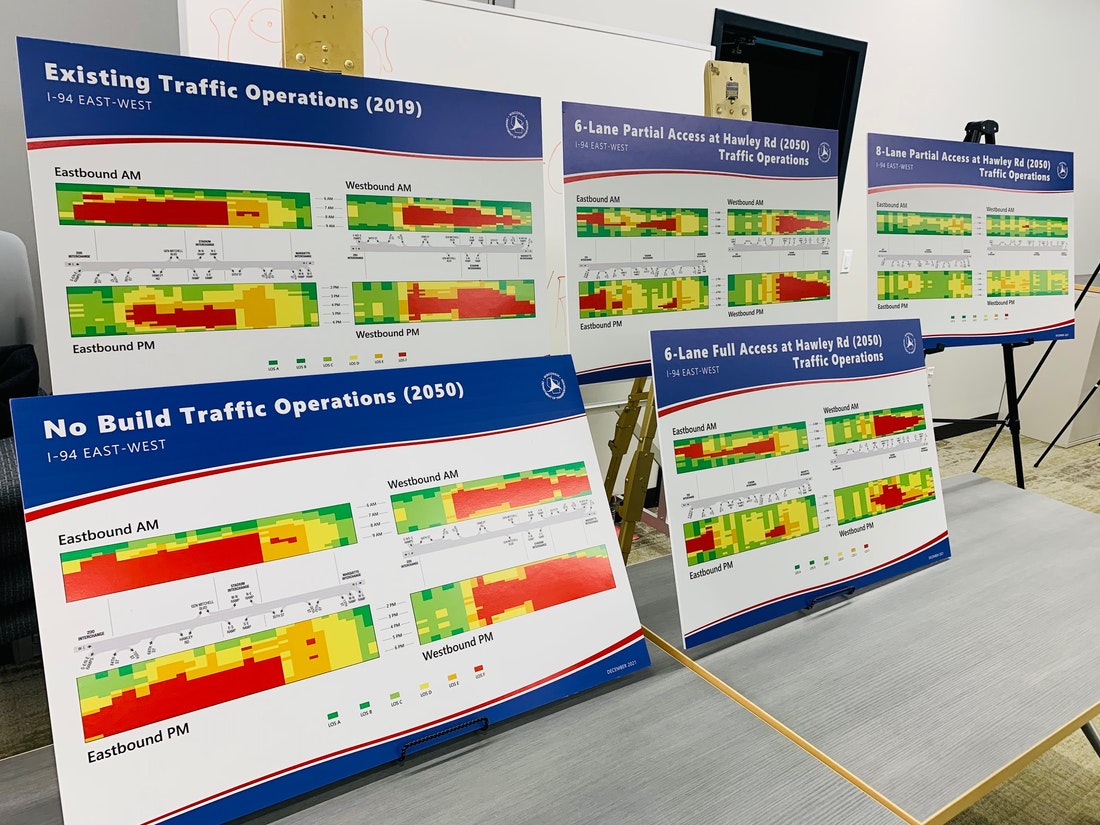9 Takeaways on New Stadium Interchange
Costs rising, congestion data lacking, but expansion seems inevitable.

The proposed expansion of I-94 would add a new lane going in each direction and would significantly expand the Stadium Interchange. Photo from Wisconsin DOT.
This last month saw the most significant amount of change to the I-94 East-West project we’d seen since Gov. Tony Evers reintroduced it last year. That includes news about the project’s rising price tag and a new timeline. Here are nine takeaways, first published by The Recombobulation Area, on what it all means.
1. This is really the Stadium Interchange Project
For much of the time as this project has been discussed, it’s been referred to as the I-94 East-West project. After seeing the renderings and talking to folks from WisDOT at recent public involvement meetings, perhaps we should start calling it the Stadium Interchange Project.
“The main driver is really what the Stadium (Interchange) will look like and how that will function,” he said. “That’s where most of the project is going to be located.”
Pyritz did not have an estimate for how much the Stadium Interchange would cost on its own, but he did say that it would be the majority of the project’s cost.
Both primary options for the reconstruction are now projected to cost between $1.2 billion and $1.3 billion, and what would be the same under both six-lane and eight-lane options is the Stadium Interchange. There is no smaller Stadium Interchange option to coincide with the proposal for fewer lanes. It is going to be massive, regardless.
2. Why did the cost estimate for the six-lane option grow so much?
The biggest takeaway revealed this week was the surprising jump in cost for the project’s six-lane option, going from the $800 million to $850 million range to more than $1.2 billion.
The main reason why, Pyritz said, is that both options have the Stadium Interchange in common, and both options also have similar designs at the 35th Street, 25th/26th Street, and 68th/70th Street interchanges.
“When people were looking at this, they were expecting maybe a much larger delta as far as the cost differences that we’re seeing and thinking that we’re seeing, so that’s why they’re actually pretty similar,” he said of the similar interchanges for each option. “Most of the design and layouts are very similar. The areas where there’s the biggest impact – the interchanges and the Stadium Interchange itself – are the main drivers for the cost. That’s why the numbers are a little closer together than I think some people were expecting.”
“A lot of those numbers were based on previous numbers, and I think (WisDOT Secretary Craig Thompson) mentioned at that time (April 2021, in an interview with The Recombobulation Area) that these numbers were pretty raw. In the initial phase of this study, the previous one, we moved away from the six-lane (option) pretty quickly. There wasn’t a lot of real, in depth looking at that. They were certainly reviewed and investigated, but there wasn’t the same level of depth that we’re now getting into in looking at the six or the eight.”
That mirrors what expansion opponents had been saying all along, that the widening option was the only one to have received any serious consideration from the state before this year.
So then WisDOT’s reasoning for the huge cost increase essentially amounts to this: The six-lane option was never meaningfully studied in previous versions of this proposed project, and now that it has, they’ve determined that the cost would be more than 40% higher than rough estimates. The main reason for this is that the Stadium Interchange and several other interchanges along the interstate would be the same in each option. That’s why there’s a less than $75 million difference between the two options.
3. The cost increase seriously undermines the “Fix at Six” effort
Intentional or not, the huge cost increase for the six-lane option certainly undermines the “Fix at Six” alternative plan released in September by the Coalition for More Responsible Transportation (CMRT). The argument for fixing at six lanes and steering any additional funding that might be available toward transit and other multi-modal infrastructure becomes more challenging if the funding gulf between the two highway reconstruction options shrinks to the degree that it has.
Given the deep distrust many expansion opponents have of WisDOT, it wouldn’t surprise me if many come to the conclusion that this funding increase was specifically engineered to undermine their position.
Not unlike a decade ago with the Zoo Interchange expansion, a lawsuit from many of these groups seems inevitable.

An illustration of the proposed Stadium Interchange expansion, looking southwest. Image from Wisconsin DOT.
4. The Stadium Interchange is going to be a little weird
I’m waiting on the detailed visuals from WisDOT so you can see this a little more clearly, but this interchange could be a little funky.
The simple part to understand is that there would be no more exits to the left side of the highway, in any piece of the interchange – a trend continuing from the Zoo and Marquette interchanges to promote greater safety on the roads. This also means the nearby Mitchell St. exit will be removed. This was all expected.
The more complex piece is how plans call for four levels of highways and overpasses at the Stadium Interchange. The first level would be exits descending from the interstate, the next the East-West portion of I-94, the next would be State Highway 175, and the next would be additional overpasses that offer some of those connections. And on that third level, Highway 175 would actually come to a full stop in the center of the interchange at a stoplight – not like a metered on-ramp stoplight, more like one you’d see at a city intersection – as 175 intersects with overpasses connecting 175 to I-94.
But don’t worry, WisDOT has a great record with recent interchanges…
5. Why do we need this gigantic interchange?
Once the Stadium Interchange is completed, there will be four massive and recently rebuilt interchanges in a less than 10-mile stretch of highway within Milwaukee County.
That seems like a lot. Too many, perhaps. With the Lakefront Gateway, the Marquette, the Stadium, and the Zoo, that is just so many highways cutting through Milwaukee.
WisDOT documents shared show that Highway 175 sees an average of 53,600 vehicles per day south of I-94 on Brewers Blvd./Miller Park Way and an average of 73,600 vehicles per day north of I-94 on the Stadium Freeway. Other diamond interchanges have an average traffic volume of 20,000 to 37,000. And the Zoo Interchange, Pyritz said, sees “about 180,000 vehicles” per day on the north leg.
Additionally, documents say the “proposed Stadium Interchange needs to accommodate relocated General Mitchell Blvd./stadium access and traffic within interchange footprint.” So, traffic heading to American Family Field for Brewers games on 81 scheduled days per year certainly has an impact on the redesign of this interchange, as well.
6. The Stadium Freeway could still be torn down
One of the key opposition proposals has been to convert the Stadium Freeway to a boulevard. It’s something we’ve advocated for here in a column with the headline, “Tear Down the Stadium Freeway.” Highway 175 already is a boulevard south of the interstate, and converting the less than two-mile stretch of freeway to something that could invite redevelopment, open up access to Washington Park, and connect segregated neighborhoods would be a game-changer for Milwaukee.
“The East-West project, its terminus at the north end is at Wisconsin Avenue,” said Pyritz. “Whatever we leave at that spot will be able to interact and function equally well, whether it stays in a similar configuration as it is today, or, there’s been some thoughts about making it a boulevard or changing the scope of it, changing how it interacts with the neighborhood.”
He continued, “Anything that we leave at Wisconsin Avenue, anything that happens north of that will be able to be integrated very cleanly into the new modern Stadium (Interchange) design…At some point that roadway is going to need to be redesigned and reconstructed. What that’s going to look like, as of today, I couldn’t tell you.”
Short-term, the north spur of 175 is not going to be part of the East-West project. But long-term, WisDOT is not committed to the Stadium Freeway remaining in its current highway form. There’s still a real opportunity for lasting, meaningful change to be realized on the west side of the city by converting this highway to a boulevard.
7. Congestion projections lack key context
One of the many displays WisDOT presented at its public involvement meeting was on congestion projections for the various options (above). They showed how adding a lane could affect congestion, but they didn’t indicate what any of that would mean in real time, and didn’t take into consideration Milwaukee’s already low commute times, as compared to other large cities. Milwaukee ranks as one of the least congested major metropolitan areas in the world (400th out of 416 cities, in 2019 numbers), and in the bottom 10% of metros in North America for average traffic times. This data, as presented, is not particularly useful.
8. Is there a “model” for what a successful highway expansion could look like?
When I was writing for BizTimes Milwaukee and Milwaukee Magazine, one of the topics I covered closely was the debate over the new arena for the Milwaukee Bucks. And one of the ways the project was always examined, dating back to the idea phase even before the team was sold, was through various examples of how arenas were funded and designed in other cities. Places like Brooklyn, Charlotte, Cleveland, Denver, Oklahoma City, Orlando, Sacramento and even NHL cities like Pittsburgh, Columbus and St. Louis were all examined in some capacity as the big players on the project charted course for a new arena in downtown Milwaukee. As that process eventually unfolded, the better parts from many of these examples were pieced together to create something that has ultimately proven to be a genuinely transformative project for downtown Milwaukee.
“We don’t necessarily look for somebody else to try to copy their system,” said Pyritz, when I asked him about whether there is a model for successful highway expansion in a large city that he could point to. “We use what are sound engineering principles to design it. And those are dictated by what we’re looking at as far as what you’re building it on, where you’re building it, and how you can build it.”
What’s startling to me is just how narrow the vision for this project is. There’s no creativity, no aim for anything transformative, no examination of anyplace else that might be doing things differently. They’re just doing the same damn thing over again, almost identically. In more than a decade of covering big projects around Milwaukee, I don’t know of anything else that has been approached with such myopic tunnel vision. We’re going to be stuck with this visionless reconstruction for another half-century. It’s a real disappointment.
9. Expansion is (almost certainly) happening
This has always been the likely outcome, but the findings of the last few weeks really drove it home. Unless something genuinely surprising happens, this highway is going to be widened to eight lanes in the city of Milwaukee, and the Stadium Interchange is going to be massively expanded. I suppose there’s always a chance that Pete Buttigieg’s Department of Transportation could step in and block the project, but I’m too much of a realist to be holding out hope for such a move. They’ve examined a second option, but crafted it such that there would really only be one option to be chosen.
Another chapter in Milwaukee’s overpass love story seems likely to be written, and divisions in our city seem destined to expand.
Dan Shafer is a journalist from Milwaukee who writes and publishes the award-winning column, The Recombobulation Area. He previously worked at Seattle Magazine, Seattle Business Magazine, the Milwaukee Business Journal, Milwaukee Magazine, and BizTimes Milwaukee. He’s also written for The Daily Beast, WisPolitics, and Milwaukee Record. He’s on Twitter at @DanRShafer.
Op-Ed
-
Unlocking Milwaukee’s Potential Through Smart Zoning Reform
 Jul 5th, 2024 by Ariam Kesete
Jul 5th, 2024 by Ariam Kesete
-
We Energies’ Natural Gas Plans Are A Mistake
 Jun 28th, 2024 by John Imes
Jun 28th, 2024 by John Imes
-
Milwaukee Needs New Kind of School Board
 Jun 26th, 2024 by Jordan Morales
Jun 26th, 2024 by Jordan Morales
Transportation
-
MCTS Adds 28 New Buses
 Jul 13th, 2024 by Graham Kilmer
Jul 13th, 2024 by Graham Kilmer
-
MCTS Designing New Bus Shelters
 Jul 10th, 2024 by Graham Kilmer
Jul 10th, 2024 by Graham Kilmer
-
MCTS Updates RNC Bus Detours To Better Serve Downtown, Riders
 Jul 9th, 2024 by Jeramey Jannene
Jul 9th, 2024 by Jeramey Jannene






















